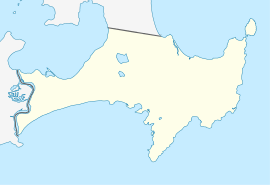Wreck Bay Village, Jervis Bay Territory
| Wreck Bay Village Jervis Bay Territory | |||||||
|---|---|---|---|---|---|---|---|
 Wreck Bay Village | |||||||
| Coordinates | 35°10′00″S 150°41′23″E / 35.16667°S 150.68972°ECoordinates: 35°10′00″S 150°41′23″E / 35.16667°S 150.68972°E | ||||||
| Population | 186 (2011 census)[1] | ||||||
| Postcode(s) | 2540 | ||||||
| Elevation | 30 m (98 ft)[2] | ||||||
| Time zone | AEST (UTC+10) | ||||||
| • Summer (DST) | AEDT (UTC+11) | ||||||
| Location |
| ||||||
| Federal Division(s) | Fraser[3] | ||||||
| |||||||
Wreck Bay Village is a village in the Jervis Bay Territory, Australia. At the 2011 census the population was 186.[1] It is a largely an Australian Aboriginal community due to the area being a former Aboriginal Australian reserve.
Geography
Wreck Bay Village is located at the northeast corner of Wreck Bay between the small coves called Mary Bay and Summercloud Bay. It is located in the south of the territory. It is about 2 km (1.2 mi) south of Jervis Bay Airport and 6.6 km (4.1 mi) by road from Jervis Bay Village.

History
The first European settlement around Jervis Bay started in the early 1880s. Wreck Bay forms part of the Jervis Bay Territory, and it became Commonwealth territory in 1915 so the national government based in Canberra could have access to the sea. [5]
Aboriginal people started a small settlement at Summercloud Bay around the early 1900s. This is because they favored the area because of strong cultural ties, its closeness to both the bush and the sea for collection of food and other sources and because of its distance from non-Aboriginal settlements. The decision to create this permanent settlement has enabled cultural practices to survive. This area later became an Aboriginal reserve known as the Wreck Bay Aboriginal Reserve that was put under control of a mission manager.[6]
The land (402 hectares) was officially handed to the Aboriginal community in 1995 by the Australian Government. [7]
References
- 1 2 Australian Bureau of Statistics (31 October 2012). "Wreck Bay". 2011 Census QuickStats. Retrieved 8 May 2013.
- ↑ Topographic map 9027 Jervis Bay
- ↑ "Fraser". Australian Electoral Commission. 21 November 2012. Retrieved 8 May 2013.
- 1 2 3 "Jervis Bay (Point Perpendicular AWS)". Climate statistics for Australian locations. Bureau of Meteorology. Retrieved 8 May 2013.
- ↑ http://www.environment.gov.au/topics/national-parks/booderee-national-park/culture-and-history/european-history
- ↑ http://www.environment.gov.au/topics/national-parks/booderee-national-park/culture-and-history/aboriginal-culture-and-history#
- ↑ http://www.environment.gov.au/topics/national-parks/booderee-national-park/culture-and-history/aboriginal-culture-and-history#
| ||||||||||